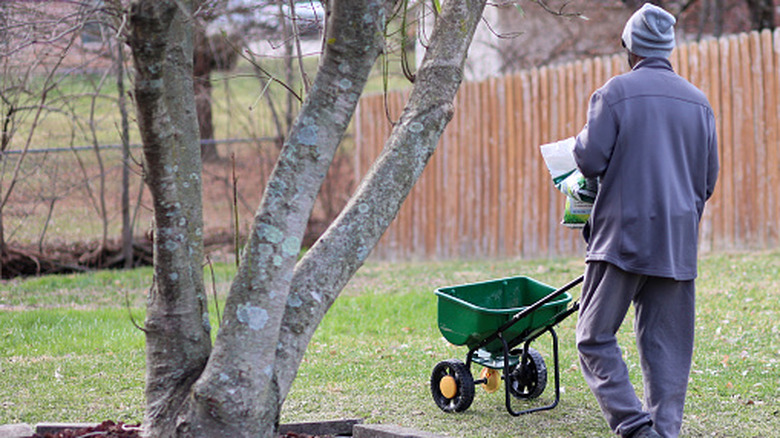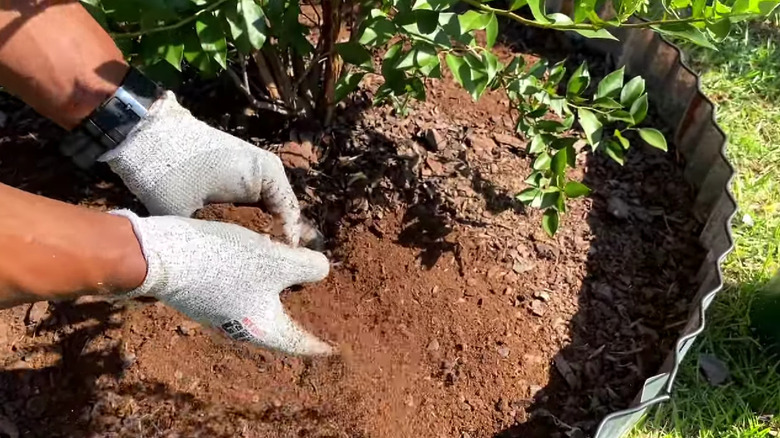The Unexpected Fertilizer To Use In Fall That Boosts Soil And Plants All Winter Long
Most gardeners think of spring as the time to feed their garden beds. That's when plants wake up from their dormancy, after all. While that's true, there is an often-missed chance to fertilize in the late fall, too, a time when you can prepare your soil for the busy growing seasons ahead. While a manufactured fertilizer in spring can give your plants a boost, don't skip the slow, foundational fertilizing that can be done with organic products in the fall. They can help maintain the long-term soil health of your garden in fall and winter. One such fertilizer is cottonseed meal.
If you've never heard of this material, that makes sense. It is one of the most underused and lesser-known of the slow-release fertilizer options. Cottonseed meal is a finely ground byproduct leftover from the process of extracting cottonseed oil – a common kitchen ingredient that can also be used for DIY pest control. Applying cottonseed meal in the fall can help your plants develop stronger roots as well as help them settle in better and wake up quicker after winter dormancy.
Cottonseed meal boosts soil and plants in winter
One of the key benefits of organic fertilizers like cottonseed meal is that they stimulate soil microbial life while also providing a gradual and extended release of nutrients. This gradual availability is ideal for fall applications. It provides lasting nutrition without the risk of pushing quick late-season growth that will become damaged in winter.
Cottonseed meal typically has an NPK ratio of 6:2:1or 4:4:2 depending on the manufacturer and source. If you aren't aware of what those fertilizer numbers really mean, they show the percentage of each nutrient. Compared to other fertilizers, the nutrient content of cottonseed meal is relatively low, and a balanced mix like 4:4:2 will gently support greener leaves and stronger roots. This makes it an excellent choice around evergreens and coniferous trees, which are often still growing in winter. Cottonseed meal is also especially helpful for acid-loving plants like blueberries and azaleas because it also lowers the soil pH. It also improves nutrient uptake and beneficial microbe activity in the soil, which is vital for maintaining fertility and plant health.
In addition, since cottonseed meal is a plant-based compound that's rich in organic matter, it can help improve soil structure. That's because organic matter acts like a reservoir for both nutrients and water. It loosens compacted soil, improves water flow, and boosts the soil's ability to hold moisture.
How to use cottonseed meal to fertilize your plants
As good as cottonseed meal is as a fertilizer, you shouldn't just dump it in your garden. It's wise to always start with a soil test before applying any amendments. A soil test will help you determine what nutrients are lacking in the ground and if cottonseed meal will even be helpful. For instance, if a test reveals your soil is already highly acidic, you should avoid using cottonseed meal, as it will further acidify the pH of your soil.
If the test indicates that a gentle fertilizer would be beneficial, you can apply cottonseed meal by incorporating it directly into the ground, using about 3 to 6 pounds for every 100 square feet of garden space. If your plants are in containers, mix in 1 to 2 tablespoons of fertilizer per gallon of soil. If you're using cottonseed meal to fertilize trees and shrubs, for every inch of the trunk's diameter, spread about 1 pound of fertilizer around the base. Mix it lightly into the soil, and water it in well. While applying, beware of the common mistakes people make when fertilizing gardens.


